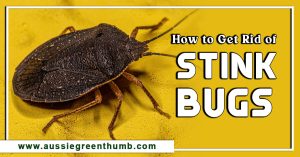Have you noticed your citrus leaf curling? Citrus trees are bright and incredibly fragrant additions to the garden, and can be grown indoors, outdoors, in containers or in the soil throughout Australia.
Their exciting and vibrant fruits are staples in the kitchen for savoury and sweet cooking alike, but due to their mediterranean preferences they can suffer from over-watering and under-feeding.
There are a few reasons why citrus leaves may curl:
- Temperatures are too cold or too hot
- An insect infestations such as aphids, mites, scale or mealy bugs.
- Over-watering.
- Or leaf curl disease.
In this article I’ll discuss some of the easiest ways to avoid one the most common citrus plant problems, citrus leaf curling, and how to deal with it.
More...
What Does Citrus Leaf Curling Look Like?
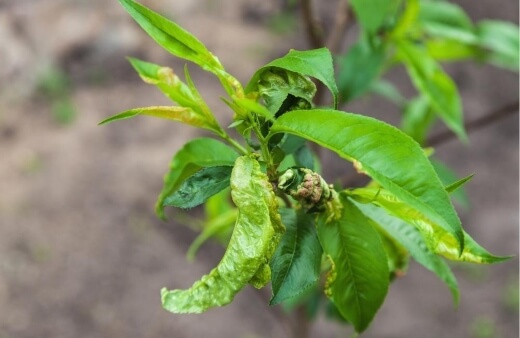
Citrus Leaf curl on citrus is caused by a lack of moisture in citrus leaves. At first sight citrus leaves look shrivelled and shocked, and later they will fall from the plant, which sadly, if left uncontrolled can exacerbate the problem further.
Curling leaves wrap inwards along the length of their midrib, while the tip can slowly start to turn from verdant green, to pale yellow, to brown.
Curled citrus leaves are often accompanied by brown patches on leaves that spread outward from the midrib of the leaf too. The brown patches appear before leaves start to curl, and the curl is a direct result of the burning due to the tightening of leaf cell structure when they are starved of water.
Essentially, cellulose in the cells is lost while the plant fails to send water to the leaves, and as the cells dehydrate they tighten, pulling the rest of the leaf inward.
What Plants Does Citrus Leaf Curling Affect?
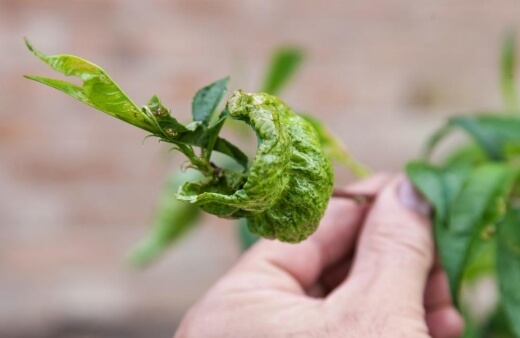
Citrus leaf curl affects every plant in the citrus family, from grapefruits to lemon trees; oranges to lime bushes. No matter what size, age or variety your citrus plant is, citrus leaf curl is always a risk and is a sign your lemons and limes are unhappy.
Curling leaves on your citrus plants are an affectation of the plant directly related to the acidity and flavor of the fruit. Like all fruiting trees, they need high nitrogen and high potassium feeds to support leaf and fruit production respectively.
Citrus need potassium in particular, which requires slightly acidic soils and well drained conditions to be properly processed by the plant. But there’s more than nutrients that can lead to curling citrus leaves…
What Causes Citrus Leaf Curling?

Citrus leaf curl is caused by a lack of moisture in the extremities of plants. If leaf curl hits during fruiting, your fruits will fail to ripen, and it is unlikely you will recover your crop this year, but fast action may be enough to save some fruits.
The two most common reasons are in sufficient watering or water retention in the soil, or pests, which can burrow into citrus stems, or even the base of leaf petioles, causing a blockage that the plants can’t pass water through or around.
Strangely though, over watering can lead to this lack of water in the leaves, but this is less common, and only causes leaf curl when over watering has begun to cause root rot. We’ll look into each possibility below:
Citrus Tree Pests that Cause Leaf Curl
Aphids and Spider Mites are the most common garden pests, and two of only a handful of citrus pests that can occur in Australia.
Aphids on citrus trees
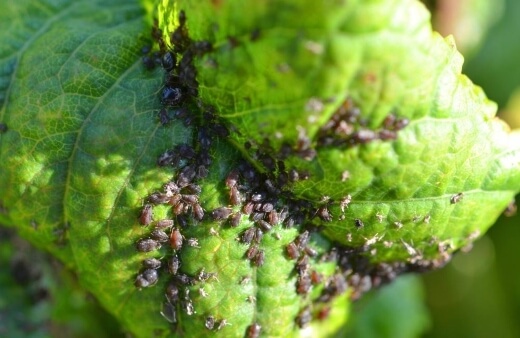
Aphids have a unique effect on lemon trees and lime trees as they are attracted by the fragrant essential oils in the leaves. While spider mites are attracted to dry conditions, aphids will land on healthy plants and suck the sap and moisture out of leaves.
If you ever notice white clusters on the underside of leaves, the rest of the plant can be healthy, and single leaves will be entirely dehydrated. If this is the case you can cut off the affected leaves and treat the rest of the plant with an organic pesticide to prevent spread.
Aphids only harm to part of the plant they colonise, and rarely cause fatal effects. For long term control, introducing aphid predators like ladybirds into the garden can control the population naturally.
Spider Mites on citrus trees
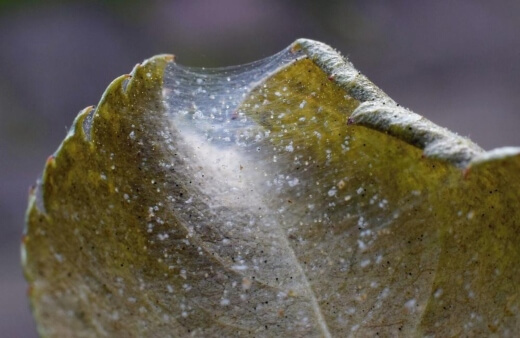
In dry conditions, spider mites can thrive, so the ideal well drained conditions for citrus trees can lead to mites on plants that feed on leaves, and attract ants.
These ants feed on mites and store nectars on the base of leaves and new growth tips leading to fungal infection. If fungal infection blocks water uptake, the plant can have moist soil but dry tops and leaves.
To spot spider mites look for patches of fine white silk webbing. This is where they lay their eggs, and to control the population simply wipe it off, and treat the leaves with a natural pesticide like neem oil, or an organic option like rubbing alcohol.
Another key sign of spider mites is small yellow spots. If you notice early signs of spider mites, rather than using pesticides or alcohol, washing leaves with soapy water can be a very effective deterrent.
Citrus Tree Diseases that Cause Leaf Curl

Root Rot
Root Rot caused by over-watering can inhibit water uptake in your citrus plants. The only way to treat root rot is to trim any damaged roots.
To find root rot, take the entire plant out of its pot, and shake off all soil. Trim any black or dead roots and cut the top growth back to an amount that the remaining roots can support.
Then wash the roots with rain water, and clean the pot before putting back in the pot in clean soil. Water well with a liquid seaweed fertiliser to help boost root growth and support the remaining leaves.
Check out our guide on fertilising citrus trees for more details.
Citrus Plant Conditions
Under Watering
Rather than strictly suggesting under-watering, I’m using it as a very general term. One mistake gardeners make when they start growing citrus plants is to make their potting mix too well drained.
Every guide you read for how to grow citrus suggests well drained compost, but it is important to realise they still need good water retention too.
If your potting mix has no water retentive compost in, consider repotting it to include a loamy garden compost, leaf mould, or water retention crystals.
Do you want to make your own compost? Check out our article on the best worm farms in Australia for 2024.
Citrus leaf curl caused by poor water retention or under-watering can be easily rectified by improving the potting mix and maintaining a weekly watering and feeding routine.
Wind
Wind burn is a very common problem with citrus trees, carrying moisture away for the plants at too high a rate. While citrus doesn't require any significant humidity, wind burn is caused by forcing any moisture held on leaves away, and drawing moisture out of them faster than they naturally transpire.
If you see no sign of pests, have healthy buds forming, and yet still find signs of leaf curl on citrus plants, then try moving them to a sunny but sheltered position away from high winds. This should help to reduce the signs of curling leaves within 2-3 weeks.
Preventing Citrus Tree Leaves Curling
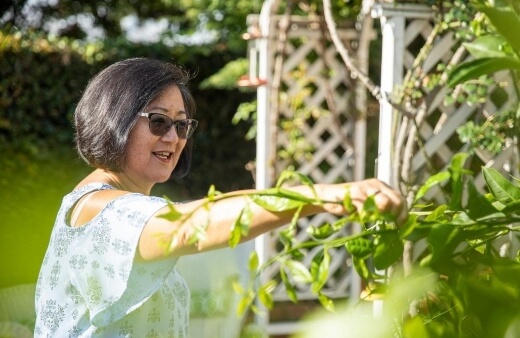
To help prevent citrus tree leaf curl if you’re worried about it in warmer parts of Australia, or if you grow citrus on balconies, make sure your plants are placed in a sunny sheltered position, away from direct winds, and have ready access to water, and a weekly fertiliser of liquid seaweed.
Liquid seaweed has the ideal nutrient levels for citrus, and boosts the flavour of the final fruits in a big way.
There are plenty of natural ways to boost water retention, like a thick mulch every spring to stop water evaporation from the soil surface, or adding a small amount of well rotted manure or garden compost to the potting mix.
(See our guide on choosing the right mulch for your garden.)
Citrus should be re-potted every 2-3 years, like all mediterranean plants when not grown in the ground. If you grow lemon trees in pots and see lemon leaves curling then it is possibly due to the roots being too compacted in the pot.
This is the same for lime trees too, so consider potting any citrus into a bigger container when you see signs of leaf curl. It could help, and definitely won’t do any harm.
Citrus Leaf Curling FAQs
How do I treat citrus leaf curl?
There are many different causes for citrus leaf curl, but a combination of organic insecticidal soaps, changing the soil and checking for root rot will cover all possible ground. Ensure your citrus trees are moved away from high winds.
What do curled leaves on a citrus tree mean?
Curled leaves on a citrus tree are a sign of drought shock. For a number of reasons, water stops reaching the leaves of citrus trees. It can be difficult to determine the reason, but whether it is caused by pests, diseases or drought, the end result is the same: lack of water = crispy leaves.
Do curled citrus leaves go back to normal?
Yes, citrus leaves that have begun to curl can return to their normal verdant selves. Depending on how much browning has occurred it might be too late, but if you catch leaf curl early, your lemon tree leaves curling should recover easily.
How often should a lemon tree be watered?
Lemon trees should be watered at least once a week. Despite liking well drained soil, they still require regular watering, and once fruit begins to appear in summer, they should be fed with liquid seaweed once a week.
For more details on taking care of lemon trees, refer to our comprehensive lemon tree growing guide.

Combat Citrus Leaf Curling for a Healthier, More Vibrant Garden
Citrus tend to be precious plants, and understandably make great gifts, which makes it even more worrying when they get ill. I’ve got two lemon trees, a calamondin and a lime.
Every single one of them has suffered from citrus leaf curl at one point or another. The lemons have been most susceptible to aphids but they’re usually quite easy to treat, while the lime was in the wrong spot, and moving it out of the wind really did help.
For the calamondin, it was only a young plant, and it was over-watered indoors, and I think it got too humid in the kitchen. There are all sorts of things that might be causing your curling citrus leaves, so take some time to understand your individual plants, and it will tell you what it needs.
Good luck, and I hope you feel more confident now you know what causes citrus leaf curling.
Published on January 7, 2022 by Maisie Blevins
Last Updated on February 21, 2024

